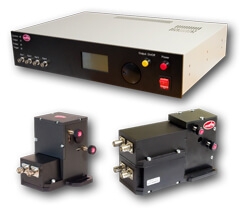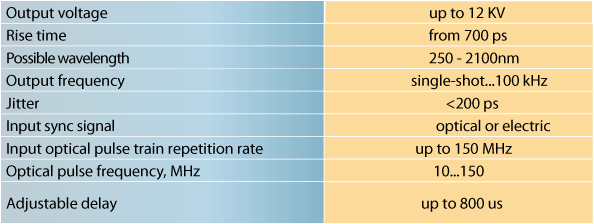OG pulse picker systems
Possible wavelength: 250 – 2100 nm
Adjustable amplitude up to 12 kV
HV pulse adjustable delay
HV pulse duration from 3 to 1250 ns
Fast rise time down to 1 ns or less
Single-shot up to 100 kHz picking rate
USB control and LabView drivers
Low jitter <200 ps
Built-in optical trigger
Two additional sync channels

1. General
The OG pulse picker systems is as a pulse gating system that lets single pulses or group of subsequent pulses from a femtosecond or picosecond pulse train pass through the system, and stops other radiation. The system is perfectly suitable for most commercial Ti:S femtosecond oscillators and amplifiers as well as for many other popular laser systems if you require quick and versatile control over pulse repetition rate.
The system can pick either single pulses, shoot bursts (patterns of single pulses) or pick group of subsequent pulses (wider square-shaped HV pulse modification). HV pulse duration (i.e. gate open time) is 10 ns in the default OG8/1 model, but can be customized from 3 to 1250 ns upon request or made variable. The frequency of the picked pulses starts with single shot to 1 kHz for the basic model, and goes up to 100 kHz for the most advanced one. The Pockels cell is supplied with a control unit that is capable of synching to the optical pulse train via a built-in photodetector unit, while electric trigger signal is also accepted.
Two additional delay channels are available for synching of other equipment to the pulse picker operation. Moreover, USB connectivity and LabView-compatible drivers save a great deal of your time on storing and recalling presets, and setting up some automated experimental setups. One control unit is capable of driving of up to 3 Pockels cells, and this comes handy in complex setups or contrast-improving schemes.
The system can also be modified to supply two HV pulses to one Pockels cell unit, making it a 2-channel pulse picker system. This may be essential for injection/ejection purposes when building a solid-state Ti:S or Cr:F regenerative or multipass amplifier system. The system comes with everything you need to set up a half-wave voltage scheme of pulse picking and synching it to your laser source. Please refer to our FAQ section for more details.
2. Specifications
3. Modifications
-Cxxxx – custom fixed HV pulse duration (gate open time) where xxxx is chosen from 10 to 1250 ns.
-V – variable HV pulse duration (gate open time) from 10 to 1000 ns. HV pulse is flat-top square-shaped.
-F- fast rise time modification. Rise times down to 700 ps upon request.
-2 – 2-channel system for driving one Pockels cell with two HV pulses. Perfect for injection/ejection in solid-statefs amplifiers.
4. FAQ
Q.What is the connection between the amplitude of the HV pulse and the operational wavelength of the pulse picker system?
A. The high-voltage driver supplies high voltage to the crystal in the Pockels cell and the crystal becomes transparent to a certain wavelength depending on the amplitude supplied and the scheme of the setup (known as half-wave or quarter-wave voltage schemes). Thus in a half-wave scheme the voltage amplitude in kV roughly corresponds to wavelength in hundreds of nm, i.e. if you require the system for 800 nm you are looking for ~8 kV unit, 1064 nm – 10 kV etc. The quarter-wave scheme reduces the necessary voltage by half opening up possibilities of wavelengths up to 2100 nm with only ~5-6 kV, but in this case the overall transmission of the system will also be reduced, as the beam will have to pass 4 times through the system vs. 2 times in the half-wave scheme.
5. RFQ Hints
Just some quick hints before you send us an RFQ:
1. Define the wavelength range that you need the system to operate in. The wavelength defines the voltage that you need for your application. See the FAQ section for further explanation on this subject or just send us the desired wavelength and we will offer the right voltage and ARC.
2. Check if you need the default 10 ns HV pulse duration (gate open state). E.g. 10 ns duration suits femtosecond pulse train around 80 MHz or 1-5 kHz Ti:S amplifier control. Other custom durations and variable modification are available.
3. Let us know if you require a 2-channel system or a second Pockels cell.
